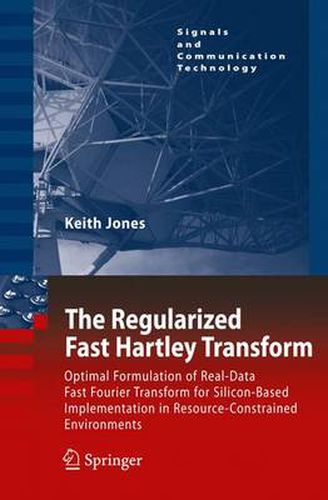The Regularized Fast Hartley Transform: Optimal Formulation of Real-Data Fast Fourier Transform for Silicon-Based Implementation in Resource-Constrained Environments
Keith Jones

The Regularized Fast Hartley Transform: Optimal Formulation of Real-Data Fast Fourier Transform for Silicon-Based Implementation in Resource-Constrained Environments
Keith Jones
This title is printed to order. This book may have been self-published. If so, we cannot guarantee the quality of the content. In the main most books will have gone through the editing process however some may not. We therefore suggest that you be aware of this before ordering this book. If in doubt check either the author or publisher’s details as we are unable to accept any returns unless they are faulty. Please contact us if you have any questions.
Most real-world spectrum analysis problems involve the computation of the real-data discrete Fourier transform (DFT), a unitary transform that maps elements N of the linear space of real-valued N-tuples, R , to elements of its complex-valued N counterpart, C , and when carried out in hardware it is conventionally achieved via a real-from-complex strategy using a complex-data version of the fast Fourier transform (FFT), the generic name given to the class of fast algorithms used for the ef?cient computation of the DFT. Such algorithms are typically derived by explo- ing the property of symmetry, whether it exists just in the transform kernel or, in certain circumstances, in the input data and/or output data as well. In order to make effective use of a complex-data FFT, however, via the chosen real-from-complex N strategy, the input data to the DFT must ?rst be converted from elements of R to N elements of C . The reason for choosing the computational domain of real-data problems such N N as this to be C , rather than R , is due in part to the fact that computing equ- ment manufacturers have invested so heavily in producing digital signal processing (DSP) devices built around the design of the complex-data fast multiplier and accumulator (MAC), an arithmetic unit ideally suited to the implementation of the complex-data radix-2 butter?y, the computational unit used by the familiar class of recursive radix-2 FFT algorithms.
This item is not currently in-stock. It can be ordered online and is expected to ship in 7-14 days
Our stock data is updated periodically, and availability may change throughout the day for in-demand items. Please call the relevant shop for the most current stock information. Prices are subject to change without notice.
Sign in or become a Readings Member to add this title to a wishlist.

